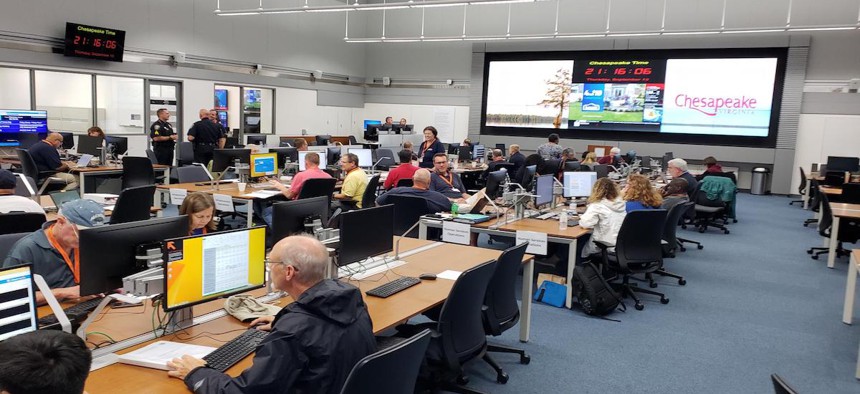Using Alerts to Keep Residents Safe

The emergency operations center in Chesapeake, Virginia. City of Chesapeake
Most large municipalities use messaging systems to push out emergency information, but getting people to register needs to be a priority.
As Hurricane Florence raced toward the Eastern Seaboard, emergency management officials in Chesapeake, Virginia used a variety of platforms to keep residents apprised of the danger. They gave updates to local media. They posted information on social media. And they sent messages, including evacuation orders, through Chesapeake Alert, the city’s official emergency alert system.
The platform, created and hosted by communications and safety solutions company Everbridge, allows government officials to send messages in a variety of ways, including text messages, emails and recorded phone calls. Virginia state law requires localities with a population of at least 50,000 to have a warning system in place, and most larger municipalities across the country use some version of a messaging service, known as a reverse 911 system, to communicate emergency information.
Typically, those systems, including Chesapeake Alert, are the only official way to receive updates from a locality’s emergency management personnel. But getting residents to sign up can be a challenge. In Chesapeake, a city with 86,000 households, just 20,000 people have registered to receive emergency messages.
“We do get a database of publicly available telephone numbers that we update annually,” said Lizz Gunnufsen, the city’s public communications coordinator. “But the key to being able to contact people effectively is to get them to register in the system, because it gives people the flexibility to put in alternate contact information. If you do evacuate, for example, you don’t want your home phone number to be the only one in the system. You still want to be reachable.”
Registration typically spikes during a major event like Hurricane Florence—two years ago, more than 350,000 people opted in to an Everbridge system during the 24 hours before Hurricane Matthew hit Florida—but new enrollees may miss the first messages sent during the incident. Promoting registration ahead of emergencies is key, but can be difficult to accomplish on a limited marketing budget, said Robb Braidwood, Chesapeake’s deputy coordinator of emergency management.
“We have roughly 86,000 households in Chesapeake, or about 250,000 people, and we really need more of these people to register to get this information. That’s a big problem for all localities,” he said. “Our census numbers say we have about 36,000 people in our Zone A evacuation area, for example, and when we sent a message out to that zone, we called about 9,500 people.”
The city works to promote registration year-round by encouraging residents to subscribe to messages related to other topics, including parks and recreation, schools and trash reminders.
“That’s one of the reasons we like Everbridge, is that it does allow us to provide subscription notifications. We use that to build the emergency notifications,” Gunnufsen said. “That’s been pretty effective for us. Those are the people we know we can reach.”
To send a message during an emergency, officials log into the Everbridge system and can choose whether to draft their own text or use a pre-written template. For phone calls, the platform can automatically translate text into voice, but officials in Chesapeake opted to record their own message for evacuation orders during Florence, Gunnufsen said.
“It’s such a profound responsibility to tell people they need to leave their homes because they’re not safe,” she said. “In this instance we felt it would be better if it was a person speaking to them. And hitting ‘send’ is the scariest thing ever.”
If an area suffers a power outage or an internet failure, customers can call Everbridge and be connected to a live operator who can send a message on behalf of a municipality, though that tends to be somewhat rare, according to Riz Karim, the company’s vice president of services and support.
“We tend to not get a huge amount of customers calling in to a live operator because in this day and age as long as you have data access, you can generally send out a notification,” he said. “But we do get a few.”
In Chesapeake, the system, in conjunction with local media reports and social media postings, kept residents well informed of evacuation orders and risk from Hurricane Florence. The storm eventually veered south, and state officials pulled back on evacuation orders before it came ashore. Chesapeake ultimately suffered no impacts from it, Braidwood said.
“The physical impacts were very, very minimal. We actually got worse flooding three days before the storm came from just a normal high tide,” he said. “Leading up to the storm, we tried to use a multi-layered approach to risk communication. The alert system is a good avenue for us. But we need people to go in there and register.”
Kate Elizabeth Queram is a Staff Correspondent for Government Executive’s Route Fifty and is based in Washington, D.C.
NEXT STORY: New Congressional Deal Could Unlock More Money for Mitigation Projects Before Disasters Strike





